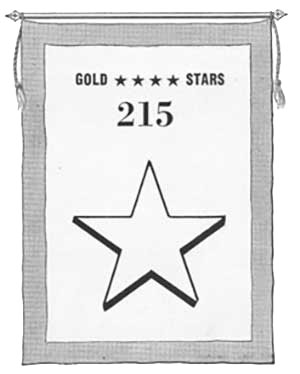How We Served: The Fed during the World Wars
When the fabric of peace has frayed in times of international struggle, countless courageous men and women have stepped forward to serve. Stories of their sacrifices are numerous, and if one looks at our nation’s history, it is apparent that service has always been a tapestry of efforts, woven together by many Americans in support of their country.
For over a century, the Federal Reserve has been an institution of people working toward a high purpose in times of both war and peace, sharing victories and shouldering defeats. This is how we served during the two World Wars.
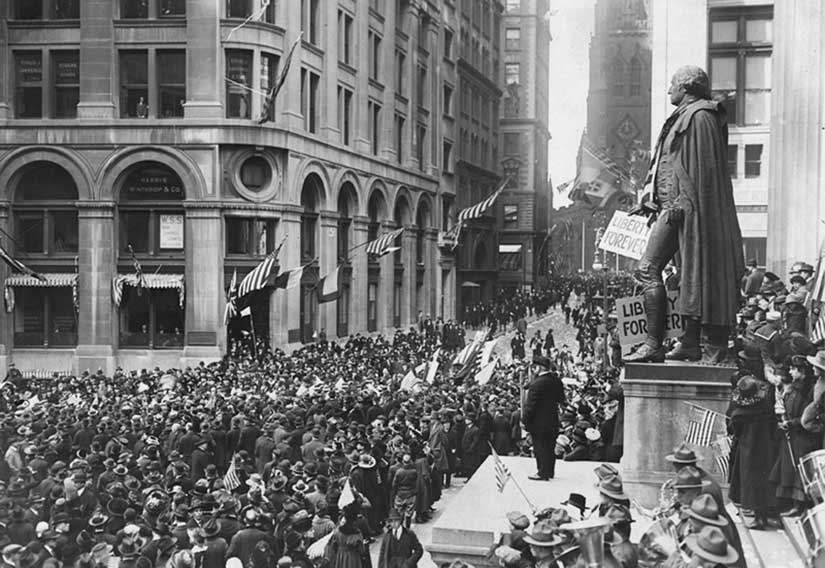
Thousands gather at the Subtreasury Building on Wall Street in New York City on Armistice Day, Nov. 11, 1918.
Public domain image courtesy of the New York Times archive.
Funding WWI Efforts: How the Federal Reserve Helped
In April 1917, the United States entered a bloody battle nearly two and a half years after it began in Europe. Three years after the establishment of the Federal Reserve banks, the nation wrestled with the question of how to fund the war efforts—and its fledgling central banking system became more important than ever. Learn how the Federal Reserve and the United States Treasury worked together to finance World War I efforts in “Liberty Bonds,” a Dec. 4, 2015, article by Richard Sutch on the Federal Reserve History website.
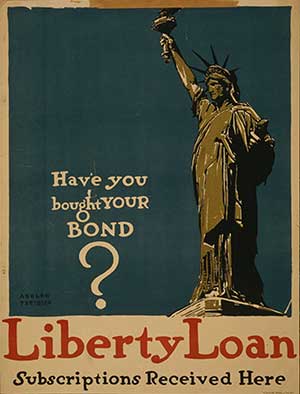
Liberty Loan poster, 1917.
Image courtesy of the Federal Reserve Bank of Cleveland Archives.
The functions and responsibilities of the Federal Reserve bank as fiscal agent of the United States were enlarged to include the sale and delivery of Liberty bonds. Bank committees were organized and each began to roll out homegrown sales campaigns. At the Federal Reserve Bank of St. Louis, this work was conducted by men’s and women’s chapters of the Liberty Loan Organization, a group of volunteers from the banking community appointed by then-St. Louis Fed leader Rolla Wells. In its third annual report, the St. Louis Fed thanked these individuals for their tireless work. “Both the men and women who served have the satisfaction of knowing that they have had a most honorable part in the service of their country in this time of its necessity,” the report said.
The St. Louis Fed Review reported that the Eighth District campaign “A Liberty Bond in Every Home” was well underway by June 1917, along with “various campaigns … urging a larger production of food stuffs” and the introduction of “meatless days” in St. Louis restaurants and hotels. In 1918, the district oversubscribed its quota of $260 million for the Fourth Liberty Loan, becoming the first to do so, according to that year’s November issue of the Review.
After the signing of the armistice treaty in 1918, the focus of war bonds shifted to rebuilding and re-establishing civil life. In 1919, the District was once again the first to subscribe its quota for bonds, this time in selling Victory bonds, the Review reported.
World War II Newsletters Celebrate Service
During the second World War, many Federal Reserve employees left their jobs to serve their country. The St. Louis Fed employee newsletter celebrated its staffers in service with monthly honor roll reports and images of the Bank’s “service flag” with a running count of its enlisted men and women. Four Four News, the St. Louis Fed’s employee newsletter at the time, hailed these employees as heroes, and not only sent copies of the newsletter around the world to enlisted men and women, but also included updates and letters received in return. (See box.)
Wartime newsletters included calls for Fed employees at home to give what they could.Find out more about how the Federal Reserve as an institution supported the war effort in “The Federal Reserve’s Role During WWII,” a Nov. 22, 2013, article by Gary Richardson on the Federal Reserve History website. “Not all of us can fight in the front lines,” insisted the April 1942 issue, “but we, who are left here, can and shall pledge ourselves … to buy Defense Savings Bonds until it hurts, and to do whatever else we can to help win this dreadful war.” Articles and items of interest were interspersed with one-line reminders, “Buy a Bond” and “Have You Bought a Bond Today?”
In 1943, the Four Four News reported that employees of the St. Louis Fed and its branches had purchased over $84,000 in bonds during the Third War Loan Drive and, in 1944, reported that employees purchased $104,708 in bonds during the Fourth War Loan Drive. Employees of the St. Louis Fed also supported the American Red Cross with contributions, donating over $2,000 in 1941 and $4,000 in March 1944, according to January 1942 and March 1944 News issues.
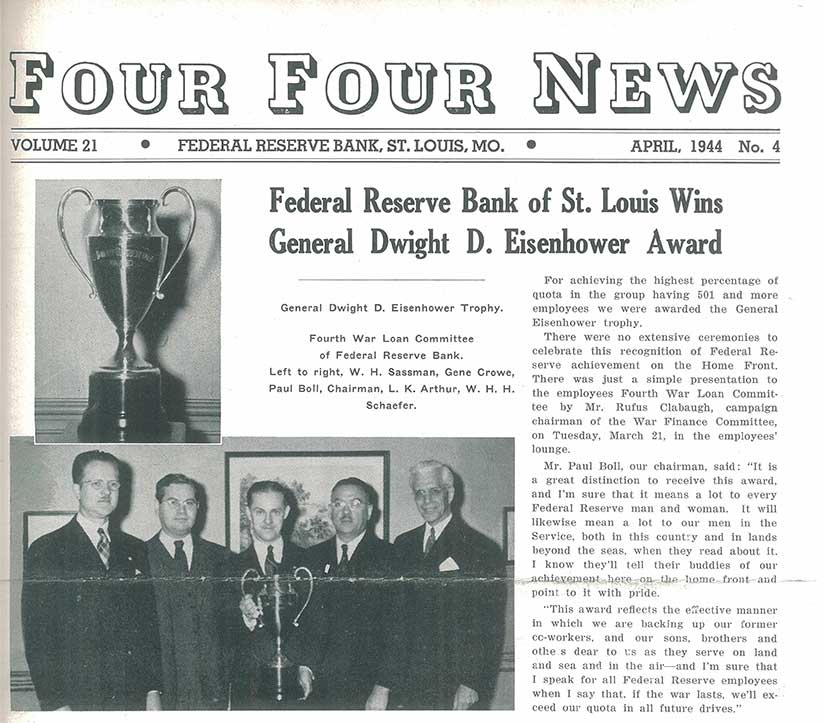
The April 1944 Four Four News reported the St. Louis Fed won the Gen. Dwight D. Eisenhower Award for its support of a war loan drive.
Image via the Federal Reserve Bank of St. Louis Archives.
For its support of the Fourth War Loan Drive, the St. Louis Fed won the Gen. Dwight D. Eisenhower Award in April 1944, and for exceeding its quota in the Victory Loan Drive by 338% in 1946, the Federal Reserve Bank of St. Louis received an “Honor Award banner.” The banner, “received from the Treasury Department through the War Finance Committee,” was hung in the corridor of the Fourth Street entrance, the News reported in February 1946.
Remembering Those Who Didn’t Return from War
As the tides of war receded, life began a slow return to its recognizable rhythms. Men and women returning to their posts at the Federal Reserve banks were warmly welcomed by their colleagues and friends. Many of those who served did not return to their jobs and families, and these losses, too, touched the Federal Reserve.
The war continued into 1944 and 1945, and the St. Louis Fed employee newsletter began to report news of losses among those overseas. In January 1943, Edward H. Segraves sent a letter to his colleagues that was included in that month’s issue of the Four Four News. “I’m eagerly awaiting the day when the battle for the preservation of democracy is ended so that I can again be among you,” he wrote. Segraves, a gunner’s mate in the U.S. Naval Reserve, was killed in action in the Pacific theater on April 9, 1945.
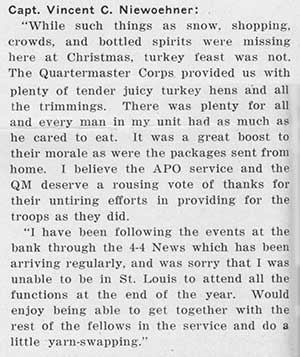
A letter from U.S. Army Capt. Vincent C. Niewoehner was printed in the St. Louis Fed employee newsletter in 1944. Niewoehner was killed in action April 29, 1945.
Image via the Federal Reserve Bank of St. Louis Archives.
His fellow Federal Reserve Bank alumnus and brother in arms, U.S. Army Capt. Vincent C. Niewoehner, died April 29, 1945, from wounds suffered fighting on the German front. Niewoehner had reached out to express his thanks for the packages sent from home in a letter that was printed in the February 1944 Four Four News. (See image.) In the letter, Niewoehner said he was “sorry that I was unable to be in St. Louis to attend all of the functions at the end of the year. Would enjoy being able to get together with the rest of the fellows in the service and do a little yarn-swapping.”
None survive times of war without being affected in some way, and this is especially true for those who served on the front lines.
From the voice of historical records, it is evident that Federal Reserve employees have navigated times of hardship with cooperation and unity. Federal Reserve Bank employees have served in every major conflict since the World Wars, including the Korean, Vietnam and Gulf wars. In recognition of their sacrifices, we offer our deep and heartfelt gratitude.
Notes
- Learn how the Federal Reserve and the United States Treasury worked together to finance World War I efforts in “Liberty Bonds,” a Dec. 4, 2015, article by Richard Sutch on the Federal Reserve History website.
- Find out more about how the Federal Reserve as an institution supported the war effort in “The Federal Reserve’s Role During WWII,” a Nov. 22, 2013, article by Gary Richardson on the Federal Reserve History website.
This blog explains everyday economics and the Fed, while also spotlighting St. Louis Fed people and programs. Views expressed are not necessarily those of the St. Louis Fed or Federal Reserve System.
Email Us


